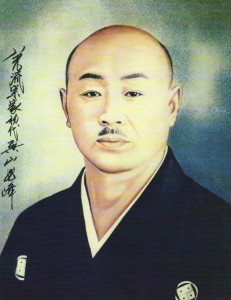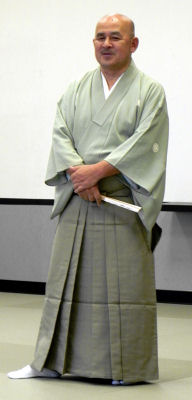History of Hakkoryu Jujutsu

“The techniques of Hakkoryu are nothing but the pure self-protection instinct that prepares your spirit to face urgent matters of life and death. That is, when one encounters violence, it can be said that Hakkoryu provides natural, simple, and practical methods that enable one to calmly face imminent peril and move on without hesitation to capture and punish assailants reasonably and easily in an instant.
The mere practice that results in the wearing out of practice uniforms does not give birth to the kind of self-protection arts that will be helpful at such critical times.
Our Hakkoryu Shodan-gi are designed to prepare one with basic rules to firmly put down such general assaults. Furthermore, as one makes progress through the Nidan-gi, Sandan-gi, and so forth, the techniques naturally increase in their punishment and severity.
We can say that the state which ensues from immersion in Hakkoryu is the same as “priming water” (that is, putting water under great pressure), which develops instincts that can explode in an instant. The advanced teachings of Hakkoryu allow for the free control of life and death. But such a choice is up to man.
The holy heart grows from the natural posture of righteousness. Therefore, dismiss evil in your heart. Only then will you be ready to learn our secrets. Relax and focus your tanden. Disinterest yourself. With the mind of Hakkoryu, your protection techniques will spontaneously and readily come out without thinking.
Calmly focus your spirit, attack the mind of the opponent and shatter his will to its depth. Hakkoryu belongs to the world where spiritual action is given priority over form and style. In Hakkoryu, there is indeed no technical skill without a spiritual determination to carry on without hesitation to life or death. Hakkoryu, therefore, is mainly for the preparation and training of the mind.
Understanding these concepts, learn and practice the spirit and techniques of Hakkoryu until they lead you to a clear perception of your wholeness. Only then can you correctly choose how best to preserve justice and humanity. Moreover, the power of one finger through Hakkoryu Koho Shiatsu can surely save man from another kind of violence emanating from deep within – illness, disease, and injury. Suddenly, these too may deprive you of your natural freedoms.
I have been preaching through the experience of thousands of people that these two violence’s, one coming from the outside and one coming from within, can be easily shut out by the proper use of a single finger. The first I have named Hakkoryu Goshin Jutsu and the other, Hakkoryu Koho Shiatsu Igaku. When I reflect on my life, I can conceive of no greater gift of wisdom to mankind and cannot help to shout out loudly, “COME OUT GREAT MAN!” because of my strong love toward my native country, Japan.”
Writings of Shodai Soke Okuyama Ryuho (1901-1987)
Composite Translation From
Okuyama Ryuho Tabinikki, Hakkoryu Ryushi Journal, Hakkoryu Higishi
Hakkoryu Jujutsu Today

For centuries in Japan, the lineage of unique bugei/bujutsu ryu have been closely guarded and handed down from father to son. The transmission is given to the eldest male child of the family whenever feasible. The one so chosen begins training at an early age, not only in the techniques and thinking of the ryu, but also in the day-to-day chores of managing and administering the dojo.
Much of the actual learning comes about through observing the father in addition to direct instruction on a step-by-step basis. Senior ryu instructors also take a direct hand in guiding “Waka Sensei” (young teacher), as he would be addressed. This process lives on today in Hakkoryu Jujutsu.
Born in 1948 as the son of Shodai Soke Okuyama Ryuho, Okuyama Toshio began his training under his father in Hakkoryu Jujutsu at age five and Hakkoryu Koho Shiatsu when he was seven. As is tradition, he was referred to as “Waka Sensei.”
From his teenage years onward, he would assist his father with Jikiden training at Hombu Dojo. He also traveled extensively around Japan, assisting his father in teaching Hakkoryu Jujutsu and Hakkoryu Koho Shiatsu. For a number of years, he was Chief Clinician in charge of shiatsu clinics both in Saitama City and Tokyo.
Outside of Hakkoryu Jujutsu and Hakkoryu Koho Shiatsu, his formal education culminated with his graduation in 1971 from the Daitobunka University in Tokyo with a degree in Economic Science and in 1973 with a certificate from Daitobunka’s Specialized Medical School in bone setting.
On April 6, 1986, he succeeded his father during his “Shumei Shiki” (“Iemoto” or Name Taking Ceremony) at the Musashi Ichinomiya Hikawa Jinja. There, upon his father’s retirement, he took the name “Ryuho” and became the Hakkoryu Nidai Soke (Second Generation Head). The Hikawa Jinja, a Shinto Shrine located in Saitama City, Saitama Prefecture, was said to have been built over 2400 years ago and is designated an “Ichinomiya” (Shrine of the First Rank). Currently there are 290 Hikawa Jinja in Japan.
Nidai Soke is well known for his ability in healing patients through Hakkoryu Koho Shiatsu. On numerous occasions, he has appeared on national television as well as in popular publications concerning medicine and health. He gives basic and advanced seminars on Hakkoryu Koho Shiatsu at Hombu Dojo and around Japan and treats difficult patients with special conditions, often traveling to visit the homes of those who are bedridden.

Aside from Hakkoryu Jujutsu and Hakkoryu Koho Shiatsu, Nidai Soke is very highly skilled in the Yakumo Mansei-en family school of bonsai. This family system was founded around early Meiji (1868). His teacher’s name is Mr. Hideo Katou. Mr. Katou, who is now in his eighties, has been a Director and Executive Judge of the Japan Bonsai Association and is currently serving his appointment to provide and care for the bonsai on display in the Imperial Palace.
In addition to Hikawa Jinja, Saitama City is actually best known for its numerous and famous teachers of bonsai and Bonsai-Mura (Bonsai Village). Nidai Soke began training in bonsai from the age of fourteen. His artwork is always on display in the garden at the entrance to Hombu Dojo and can been seen during all seasons from the medical clinic. He often offers his works for display during public exhibitions in the area, and during the yearly National Bonsai Exhibition in 1996, 1997, and 1999; Nidai Soke was given “Awards for Excellence.”
When his father retired, Nidai Soke appointed a new set of personal counselors who have assisted him in many ways to improve the way Hakkoryu is overseen and administered. One of some importance is the enforcement of rules and regulations to which all Hakkoryu Deshi and Shihan have been and are bound. Like his father before him, he holds the post of Vice President of the Association for the Prevention of Crimes in Saitama City.
